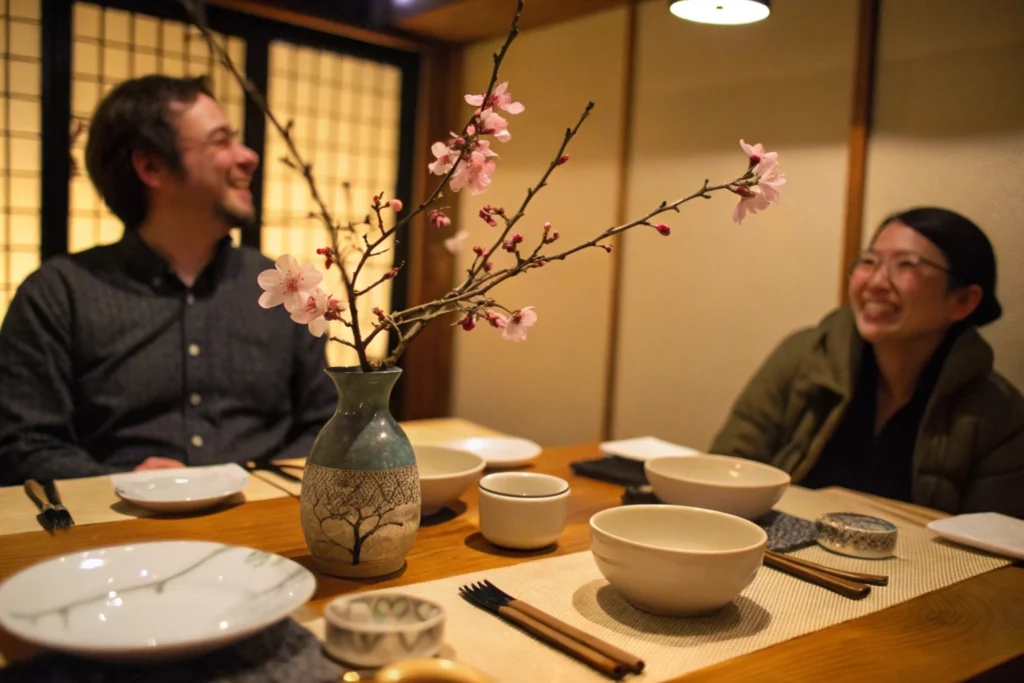When you’re searching for the best Japanese foods, you might encounter countless suggestions—from sushi and ramen to lesser-known regional gems. Japanese cuisine is celebrated worldwide for its balance of flavors, artistic presentation, and use of fresh, seasonal ingredients. Whether you’re planning a trip to Japan, hoping to explore new dishes at local restaurants, or itching to try authentic recipes at home, understanding the full scope of Japan’s culinary offerings can transform your dining experience. In this in-depth guide, we’ll explore Japan’s top foods, their histories, and how you can enjoy them wherever you are.
Explore delicious Japanese dessert options to complement your savory meals as you read on.
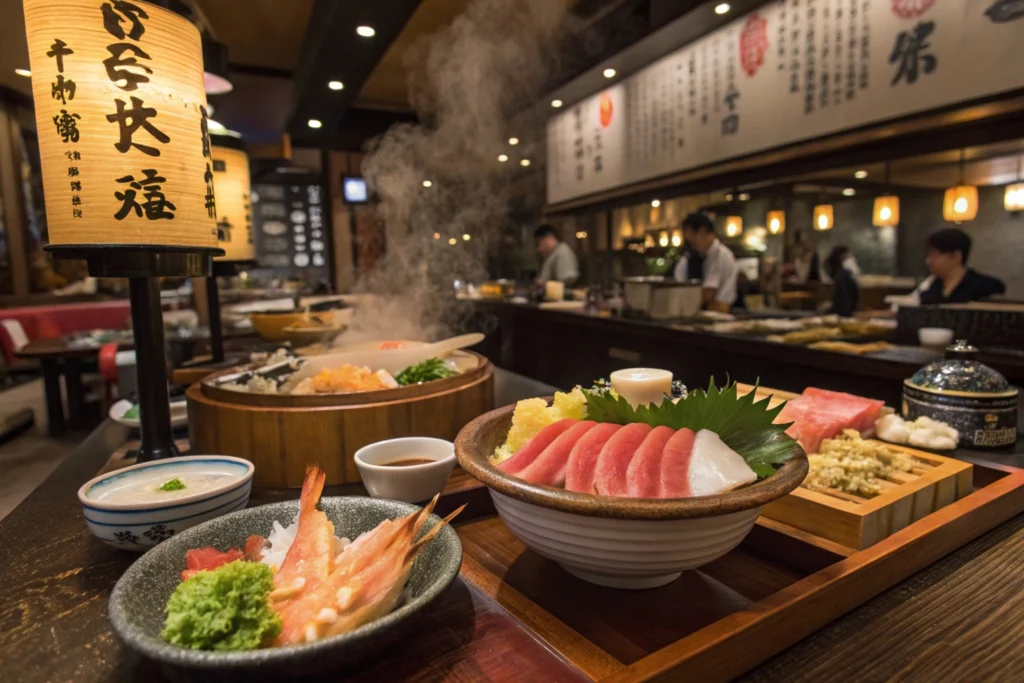
Introduction
Japanese cuisine is more than just sushi and soy sauce—it’s a tapestry woven from centuries of tradition, regional flavors, and artistic presentation. Best Japanese foods often find their roots in Japan’s reverence for fresh produce, respect for seasonality, and dedication to meticulous culinary craft. From the bustling ramen shops of Tokyo to the refined kaiseki meals in Kyoto, every region has something unique to offer.
In recent years, Japanese cuisine’s global popularity has skyrocketed, with dishes like ramen, curry, and matcha desserts becoming household names. For food enthusiasts seeking authenticity, the variety of Best Japanese Foods can be both exciting and overwhelming. This article aims to guide you through the most iconic foods, shedding light on their origins, cooking methods, and must-try variations.
Looking to recreate some of these flavors at home? Check out our japanese-chicken-fried-rice-recipe for a quick and satisfying meal that highlights Japan’s culinary flair in under 30 minutes.
Dive into the sections below for an in-depth exploration of Japan’s top dishes. By the end, you’ll not only know how to pronounce each item but also understand what makes them so special—and where to find the best versions if you decide to embark on a culinary adventure.
1. Sushi and Sashimi
When people think of the best Japanese foods, sushi and sashimi are often at the top of the list. These dishes highlight Japan’s emphasis on quality, freshness, and subtle flavor profiles. Originating from methods to preserve fish centuries ago, modern sushi has evolved into an art form prized worldwide.
Sushi Basics
- Nigiri Sushi: Hand-pressed vinegared rice topped with fish or seafood (like tuna, salmon, or shrimp). A dab of wasabi is usually placed between the fish and rice for a mild kick.
- Maki (Roll) Sushi: Ingredients like fish, vegetables, or pickles wrapped in vinegared rice and nori (seaweed). Popular rolls include tekka maki (tuna roll) and kappa maki (cucumber roll).
- Temaki (Hand Rolls): Conical nori wraps filled with rice and fillings, convenient for on-the-go snacking.
Sashimi Essentials
- Definition: Thinly sliced raw fish or seafood served without rice. Common types include maguro (tuna), hamachi (yellowtail), and ebi (shrimp).
- Presentation: Typically served atop shredded daikon radish, accompanied by ginger, soy sauce, and wasabi. The careful slicing method preserves texture and flavor.
Selecting Quality
- Freshness: High-quality sushi or sashimi relies on fish that’s minimally handled and served promptly.
- Texture & Aroma: The fish should look glossy, free of any fishy odor, and melt in your mouth when eaten.
- Balance: Skilled sushi chefs strive to balance the subtle sweetness of fish with vinegared rice and minimal seasoning.
Variations & Specialties
- Regional Styles: Tokyo’s Edomae sushi emphasizes marinating fish to extend shelf life, while Osaka’s pressed sushi (oshizushi) packs fish and rice into wooden molds for unique shapes.
- Modern Twists: Western fusion rolls like the California roll incorporate avocado and imitation crab, showcasing sushi’s adaptability across cultures.
For a deeper taste of Japanese flavors, try pairing sushi with our japanese-barbecue-sauce-recipes to see how contrasting sweet and savory sauces elevate other seafood dishes.
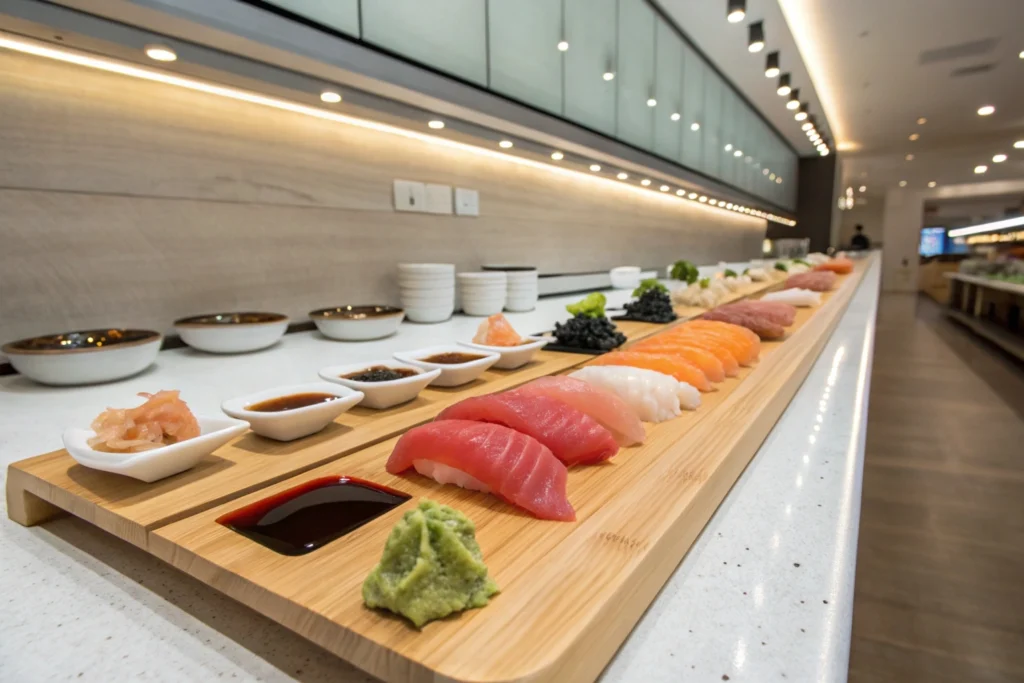
2. Ramen and Udon: Japan’s Noodle Culture
Japan’s best Japanese foods list wouldn’t be complete without discussing its vibrant noodle culture. Ramen and udon stand out as comfort foods beloved across the nation. Whether you’re indulging in a steaming bowl at a late-night eatery or making them at home, these noodles deliver big on flavor and satisfaction.
Ramen’s Rise to Global Fame
- Broth Varieties:
- Tonkotsu (pork bone): Rich, creamy broth extracted from simmering pork bones for hours.
- Shoyu (soy sauce): Clear, savory broth, typically chicken-based with a distinct soy sauce aroma.
- Miso: A heartier, slightly sweet broth combining fermented soybean paste with stock.
- Shio (salt): Lightest and most delicate broth, letting the noodles and toppings shine.
- Toppings: Common ramen toppings include chashu (pork slices), naruto (fish cake), soft-boiled eggs, and green onions.
- Regional Styles: Sapporo ramen tends to feature miso broth with corn and butter, while Hakata ramen focuses on the tonkotsu broth, recognized for its milky appearance and robust pork flavor.
Udon: Chewy Comfort
- Characteristics: Thick, white noodles with a springy texture, made primarily from wheat flour, salt, and water.
- Soup Base & Toppings: Can be served hot or cold, often in a dashi (fish and kelp) broth, topped with tempura, green onions, and kamaboko (fish cake).
- Popular Varieties: Kitsune udon (topped with sweet fried tofu), tempura udon, or curry udon (udon noodles in Japanese curry).
Noodle Shop Etiquette
- Slurping: Considered polite in Japan, indicating enjoyment and helping cool the noodles.
- Speed: Fresh noodles can become soggy quickly, so prompt eating is encouraged.
Fusion and Beyond
- Ramen Burgers: Creative spinoffs where ramen “buns” house burger patties.
- Gluten-Free Alternatives: As the global popularity of noodles soars, options like gluten-free ramen or udon are increasingly available.
For a home-based noodle adventure, explore our noodles-japanese-pan-noodles-recipe to learn how to whip up a savory dish packed with vegetables and tasty sauces.
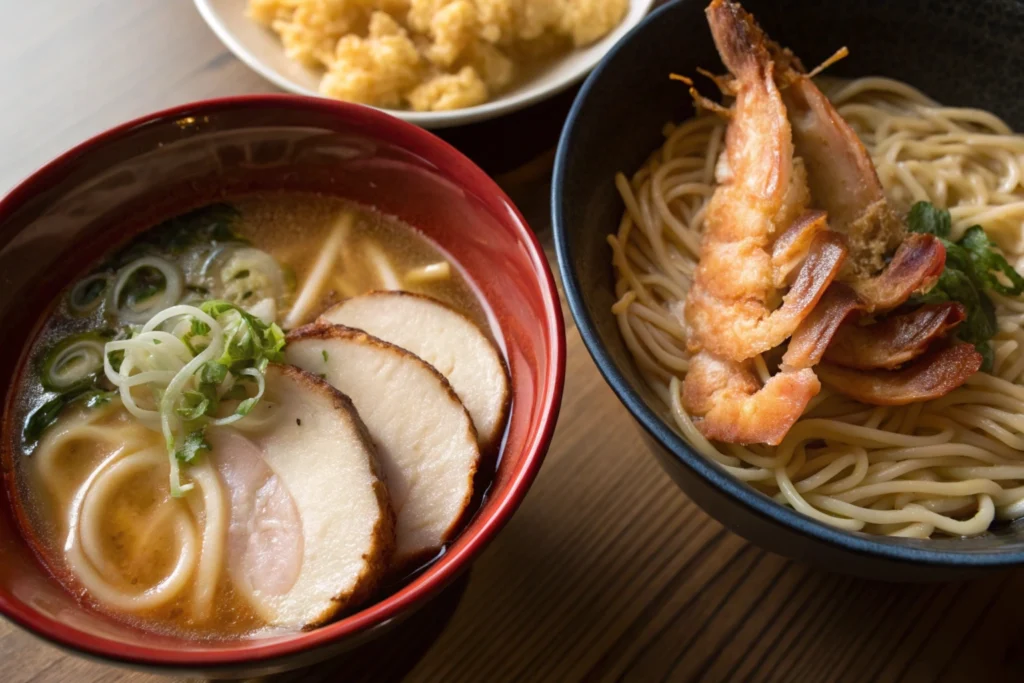
3. Tempura, Tonkatsu, and More Fried Delights
Crispy, crunchy, and oh-so-satisfying, Japan’s fried delights also rank among the best Japanese foods. Tempura and tonkatsu stand out for their delicate batters and succulent interiors, reflecting the Japanese penchant for refined flavors and textures.
Tempura: Light and Airy
- Origins: Introduced by Portuguese traders in the 16th century, tempura has since become a core part of Japanese cuisine.
- Batter: A mix of flour, cold water, and sometimes egg, whipped just enough for a light, airy texture. Overmixing can lead to heaviness.
- Common Ingredients: Shrimp, squid, mushrooms, sweet potato, and seasonal vegetables.
- Serving Style: Often served with a side of tentsuyu sauce (dashi, soy sauce, mirin), grated daikon radish, or salt.
Tonkatsu: The Perfect Pork Cutlet
- Definition: A thick, breaded pork cutlet deep-fried until golden brown.
- Variations:
- Hirekatsu: Made from lean fillet.
- Rosukatsu: Uses a fattier loin cut, adding extra juiciness.
- Accompaniments: Served with shredded cabbage, miso soup, and tonkatsu sauce (a sweet-savory blend). Some regions pair it with curry to form katsu curry, a hearty comfort dish.
Other Fried Specialties
- Karaage: Bite-sized marinated chicken fried to perfection, often enjoyed with lemon or mayonnaise.
- Croquettes (Korokke): Potato or cream-based fillings coated in breadcrumbs, reminiscent of a Western croquette but with a Japanese twist.
Fried Food Etiquette & Tips
- Crispness: Enjoy fried foods immediately to savor the fresh crunch.
- Batter Control: Japanese frying aims to enhance, not overpower, natural flavors.
- Dipping Sauces: Ponzu, tonkatsu sauce, or plain salt can all complement fried dishes.
To discover how fried dishes fit into a well-rounded meal, check out our japanese-vegan-recipes for vegetable-based options to balance out indulgent fried fare.
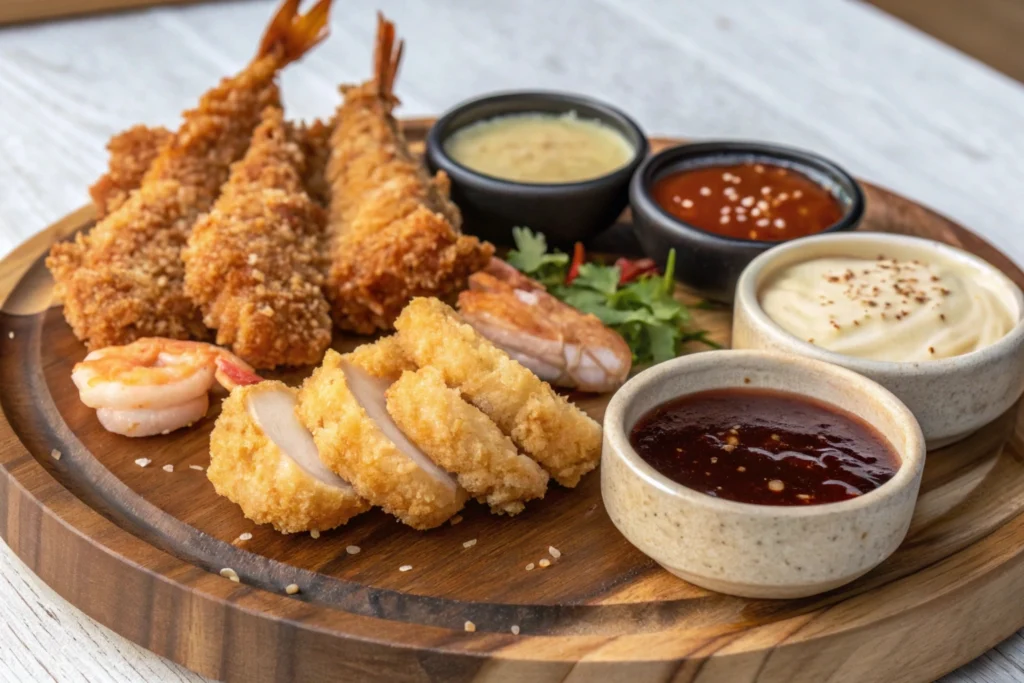
History/Context of the best Japanese foods
Evolution of Japanese Cuisine
Japanese culinary history spans centuries, shaped by local customs, religious practices, and foreign influences. The concept of the best Japanese foods continually evolves, mirroring cultural exchanges, technological advancements, and global trends.
- Ancient Foundations
Early Japan relied heavily on rice farming and seafood due to the archipelago’s geography. Buddhism influenced a vegetarian approach among monks, leading to dishes like shojin ryori, a temple cuisine focusing on vegetables and tofu. - Introduction of Foreign Techniques
Tempura’s Portuguese roots and ramen’s Chinese heritage highlight Japan’s ability to embrace and refine external influences. Over time, these imported dishes adapted to local tastes, forming entirely new Japanese traditions. - Meiji Restoration and Modernization
The late 19th century saw Japan opening to the West, bringing new ingredients and cooking methods. Katsuretsu (cutlet) eventually became tonkatsu, evolving into a quintessential Japanese dish. Western dining styles merged with Japanese ethos, birthing fusion creations. - Globalization of Japanese Food
In the 20th century, sushi, ramen, and tempura gained worldwide acclaim. Japanese chefs combined tradition and innovation, introducing new techniques like molecular gastronomy to classic dishes. The result: an ever-expanding repertoire that continues to enthrall global palates.
Cultural Importance of Food in Japan
Japan’s reverence for nature and the seasons is deeply etched into its culinary landscape. Washoku (traditional Japanese cuisine) is even recognized by UNESCO as an Intangible Cultural Heritage. Seasonal ingredients, precise techniques, and elegant presentation underscore the harmony between food, environment, and community, showcasing the Best Japanese Foods in every dish.
- Seasonality: Sakura (cherry blossom)–themed treats in spring, or matsutake mushrooms in autumn, highlight the changing seasons.
- Aesthetic and Ritual: Simple gestures like removing shoes before dining, saying “Itadakimasu” (I gratefully receive) before meals, and carefully plating food all reflect the nation’s deep respect for eating as a sacred act.
Modern Relevance
Despite fast-paced modernization, Japan maintains its core culinary principles. Younger generations relish new fusions—like Japanese-style pasta or matcha lattes—while venerable traditions endure in formal restaurants and everyday home cooking. The best Japanese foods thus blend old and new, tradition and innovation.
For a historical yet contemporary twist, consider exploring our japanese-curry-recipe-one-piece that merges pop culture references with a classic Japanese curry base, showcasing how evolving influences shape modern Japanese cuisine.
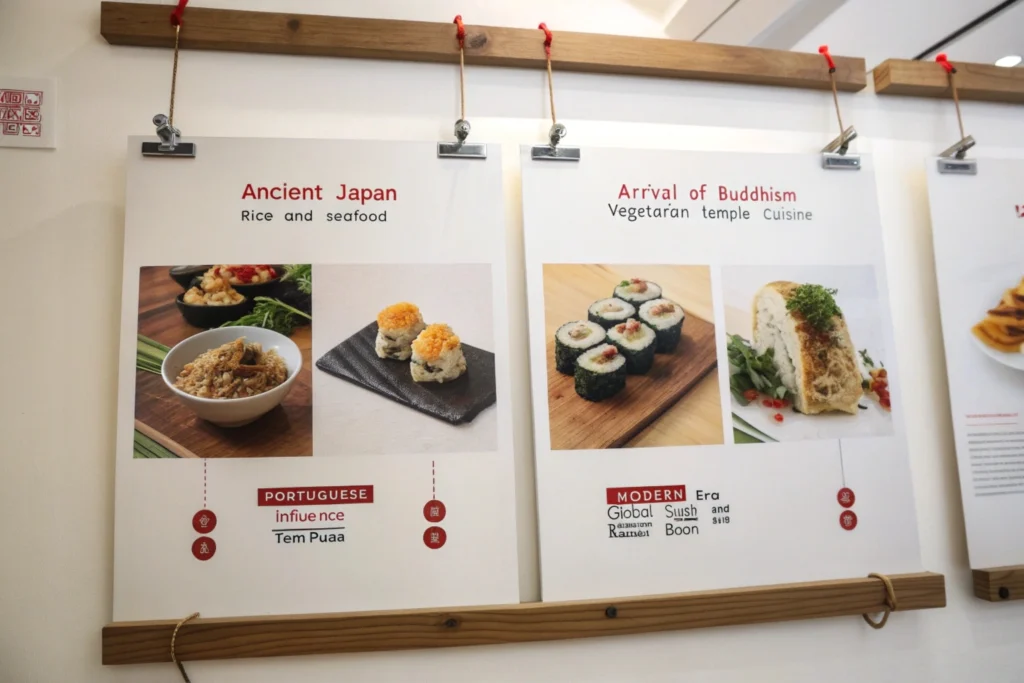
Practical Examples/Use Cases
1. Family Gathering with a Japanese Twist
Hosting a dinner party? Elevate your menu by incorporating a few best Japanese foods. Set up a sushi roll station for guests to personalize their creations, or whip up a comforting pot of curry udon. This interactive approach can spark lively conversations and bridge culinary cultures.
2. Restaurant Exploration
Planning a food tour in Tokyo, Osaka, or your local Japan-town? Print or download a short cheat sheet of must-try dishes—sushi, ramen, tempura, tonkatsu—and make sure to try the Best Japanese Foods on the menu. For a deeper flavor experience, look for small family-owned eateries that pride themselves on time-honored recipes, where you can savor authentic Best Japanese Foods crafted with care and tradition.
3. Healthy Meal Prepping
Even if you’re mindful of nutrition, Japanese cuisine offers plenty of low-calorie yet satisfying options. Swap out deep-fried items for sashimi or zaru soba (cold buckwheat noodles). Add miso soup and a side of blanched vegetables for a balanced, nutrient-rich meal. Our vegetables-japanese-recipe can guide you in preparing flavorful veggie sides.
4. Budget-Friendly Cooking
Concerned about the cost of ingredients like sushi-grade fish? Opt for simpler dishes like onigiri (rice balls) or chicken katsu. Leftover veggies can become tempura or fillings for okonomiyaki. Explore local Asian grocers for deals, and build a versatile pantry of staples—soy sauce, mirin, miso—that can transform basic ingredients into Japanese-inspired meals.
5. Cultural Appreciation
Food is a gateway to understanding Japan’s customs and traditions. Attending local festivals—like matsuri—introduces you to street snacks like takoyaki and yakisoba, letting you witness how these iconic dishes unify communities. Even learning a few Japanese phrases (e.g., “Itadakimasu!” before eating) enriches the dining experience.
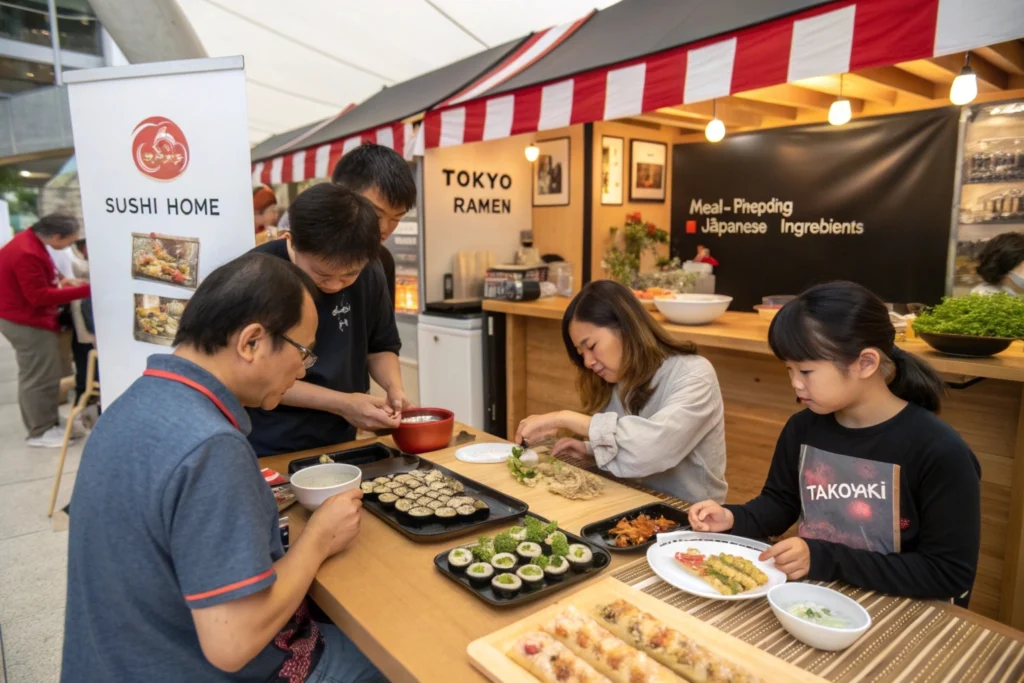
FAQs about the best Japanese foods
Q1: What are the top 10 Japanese foods?
While lists can vary, many consider sushi, ramen, tempura, tonkatsu, sashimi, yakitori, okonomiyaki, udon, miso soup, and takoyaki as top contenders for the best Japanese foods.
Q2: What food is most popular in Japan?
Staple dishes like sushi and ramen are widely popular, but everyday meals often include rice, miso soup, and pickled vegetables. Regional specialties, such as Hiroshima-style okonomiyaki or Hokkaido seafood, also have dedicated local followings.
Q3: What are five typical Japanese foods?
Five typical examples include:
- Sushi
- Ramen
- Tempura
- Sashimi
- Tonkatsu
These dishes illustrate Japan’s diverse culinary range, from hearty soups to delicate raw fish preparations.
Q4: What is Japan’s signature food?
Sushi is frequently hailed as Japan’s signature dish. It embodies the nation’s emphasis on precision, fresh ingredients, and visual presentation. However, ramen has also become an international emblem of Japanese comfort food.
Q5: Are there vegetarian versions of these popular dishes?
Yes, many Japanese foods can be adapted for vegetarian diets. Veggie tempura, vegetable ramen with mushroom or kombu broth, and tofu-based sushi are increasingly available, especially in urban hubs. Refer to our japanese-vegan-recipes for delicious plant-based transformations of classic dishes.
Q6: How do I find authentic Japanese restaurants outside Japan?
Look for places emphasizing fresh fish deliveries, homemade broths, and staff knowledgeable about regional specialties. Reading reviews or asking local Japanese communities for recommendations can also help.
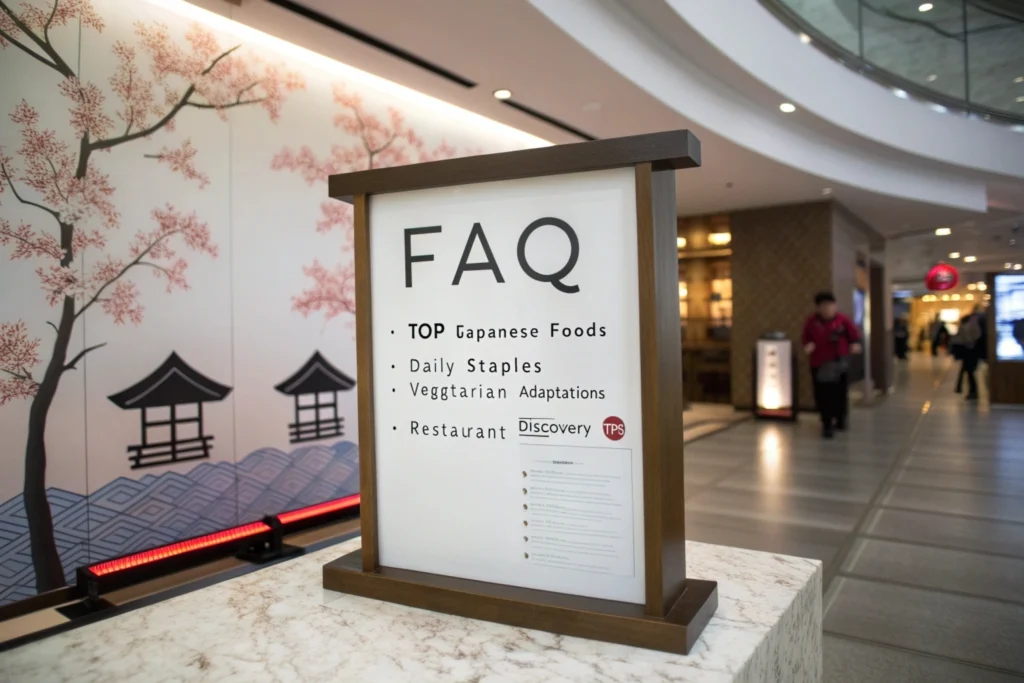
Conclusion
Best Japanese foods thrive on a balance between tradition and innovation. From the artisanal slicing of sashimi to the playful toppings on ramen, each dish reflects Japan’s deep-rooted cultural ethos—honoring quality, seasonality, and presentation. Whether you’re new to Japanese cuisine or a seasoned devotee, exploring varied dishes like sushi, tempura, ramen, and more can spark endless culinary delight.
If you’re keen to delve deeper, start by cooking one of Best Japanese Foods at home or by sampling a locally recommended restaurant. Embrace the ethos of omotenashi (Japanese hospitality) by learning basic dining etiquette, appreciating the artistry of plating, and savoring every bite.
For a sweet finale, browse our traditional-japanese-desserts-recipe for confections that perfectly complement savory mains. By immersing yourself in these flavors and experiences, you’re not just tasting good food—you’re partaking in a storied tradition that unites people from Tokyo to Toronto and beyond.
